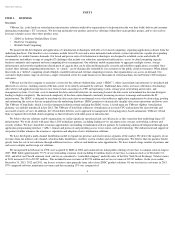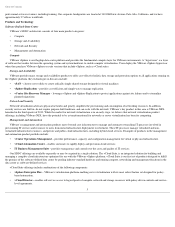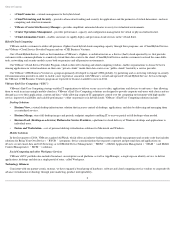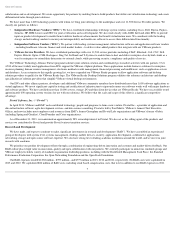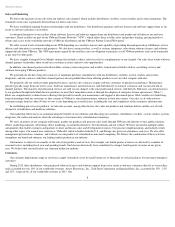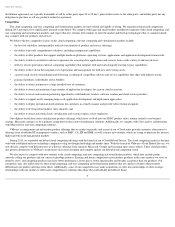VMware 2013 Annual Report Download - page 16
Download and view the complete annual report
Please find page 16 of the 2013 VMware annual report below. You can navigate through the pages in the report by either clicking on the pages listed below, or by using the keyword search tool below to find specific information within the annual report.
Table of Contents
Ongoing uncertainty regarding global economic conditions and the stability of regional financial markets may reduce information technology spending
below current expectations and therefore adversely impact our revenues, impede end-user adoption of new products and services and product and service
upgrades, and adversely impact our competitive position.
Our business depends on the overall demand for information technology and on the economic health of our current and prospective customers. The
purchase of our products and services is often discretionary and may involve a significant commitment of capital and other resources. Weak economic
conditions or significant uncertainty regarding the stability of financial markets could adversely impact our business, financial condition and results of
operations in a number of ways, including by lengthening sales cycles, affecting the size of enterprise license agreements (“ELAs”) that customers will
commit to, reducing the level of our non-ELA transactional sales, lowering prices for our products and services, reducing unit sales and reducing the rate of
adoption of our products and services by new customers and the willingness of current customers to purchase upgrades to our existing products and services.
For example, a recurrence of the sovereign debt crisis in Europe or that region's failure to recover from recession would threaten to suppress demand and our
customers’ access to credit in that region, which is an important market for our products and services. Additionally, in response to sustained economic
uncertainty, many national and local governments that are current or prospective customers for our products and services, including the U.S. federal
government, have made, or threatened to make, significant spending cutbacks which could reduce the amount of government spending on IT and the potential
demand for our products and services from the government sector.
Regional economic uncertainty can also result in general and ongoing tightening in the credit markets, lower levels of liquidity, increases in the rates of
default and bankruptcy and significant volatility in the credit, equity and fixed income markets. As a result, current or potential customers may be unable to
fund software purchases, which could cause them to delay, decrease or cancel purchases of our products and services. Even if customers are willing to
purchase our products and services, if they do not meet our credit requirements, we may not be able to record accounts receivable or unearned revenue or
recognize revenues from these customers until we receive payment, which could adversely affect the amount of revenues we are able to recognize in a
particular period.
In addition, although we plan to continue making strategic investments in our business, many of our competitors have significantly greater financial,
technical and other resources than we do, and if the economic recovery is anemic or not sustained, they may be better positioned to continue investment in
competitive technologies.
We expect to face increasing competition that could result in a loss of customers, reduced revenues or decreased operating margins.
The virtualization, cloud computing, end-user computing and software-defined data center industries are inter-related and rapidly evolving. We
experienced increased competition during 2013 and expect it to remain intense in 2014. For example, Microsoft continues to make incremental improvements
to its virtual infrastructure and virtual management products and is expected to release updated versions of its Hyper V virtualization product. In September
2012, Microsoft began shipping Windows Server 2012, which includes a more advanced version of its Hyper-V virtualization product which continues its
push into the virtualization market, and its System Center 2012 bundle of management products targeted at legacy and virtual environments. Microsoft also
has cloud-based computing offerings and recently announced IaaS-like capabilities for Windows Azure. We also face competition from other companies that
have announced a number of new product initiatives, alliances and consolidation efforts. For example, Citrix Systems continues to enhance its end-user and
server virtualization offerings and now has a client hypervisor in the market. IBM, Google and Amazon have existing cloud computing offerings and
announced new cloud computing initiatives. Red Hat has released commercial versions of Linux that have virtualization capabilities as part of the Linux
kernel (“KVM”) and has also announced plans for cloud computing products. Other companies have indicated their intention to expand offerings of virtual
management and cloud computing solutions as well. Additionally, our hybrid cloud computing offering, which allows enterprises to pool internal and
external IT resources running on a common vSphere infrastructure competes with low-cost public cloud infrastructure offerings such as Amazon EC2
and Google Compute Engine. Enterprises and service providers have also shown significant interest in building their own clouds based on open source
projects such as OpenStack.
Following our recent acquisition of Nicira and the resulting release of our NSX product, a number of competitors have announced software-defined
networking offerings. Specifically, Cisco has announced plans to ship its Application Centric Infrastructure product in the coming year.
We believe that the key competitive factors in the virtualization and cloud computing markets include:
14
•
the level of reliability, security and new functionality of product offerings;
•
the ability to provide comprehensive and scalable solutions, including management and security capabilities;
• the ability to offer products and services that support multiple hardware platforms, operating systems, applications and application development
frameworks;


